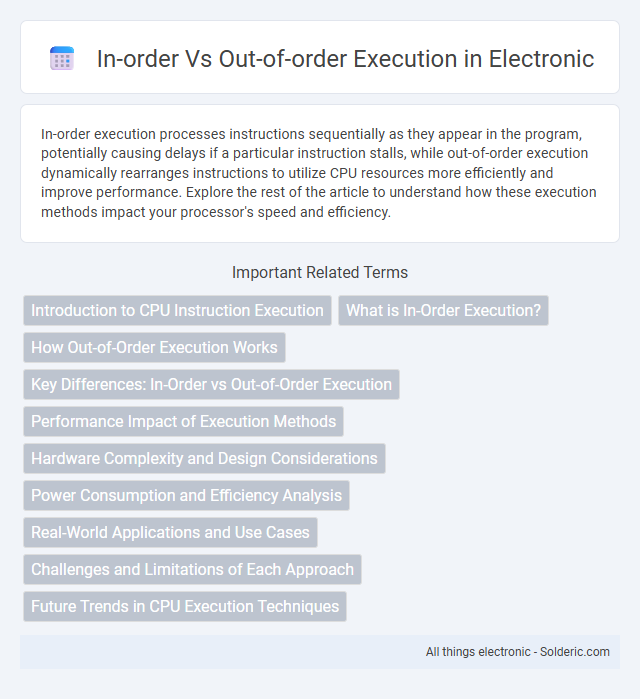In-order execution processes instructions sequentially as they appear in the program, potentially causing delays if a particular instruction stalls, while out-of-order execution dynamically rearranges instructions to utilize CPU resources more efficiently and improve performance. Explore the rest of the article to understand how these execution methods impact your processor's speed and efficiency.
Comparison Table
| Feature | In-Order Execution | Out-of-Order Execution |
|---|---|---|
| Definition | Instructions executed in the order they appear in the program. | Instructions executed as their operands become ready, not strictly in program order. |
| Performance | Lower performance due to stalls from dependencies and hazards. | Higher performance by optimizing instruction-level parallelism. |
| Complexity | Simple hardware design. | Complex hardware with reservation stations, reorder buffers, and dynamic scheduling. |
| Handling Hazards | Stalls and pipeline bubbles delay execution. | Dynamic scheduling and register renaming minimize stalls. |
| Examples | Early RISC processors like MIPS I. | Modern superscalar CPUs like Intel Core and AMD Ryzen. |
| Power Consumption | Lower power usage due to simpler control logic. | Higher power consumption from complex circuitry. |
Introduction to CPU Instruction Execution
CPU instruction execution involves processing commands in a sequence to perform tasks, where in-order execution processes instructions strictly in their original program order, ensuring simplicity but potentially causing delays due to pipeline stalls. Out-of-order execution enhances performance by dynamically reordering instructions based on operand availability and execution unit readiness, allowing parallelism and reducing idle CPU cycles. Modern processors typically implement out-of-order execution to maximize throughput and optimize resource utilization while maintaining correct program results through meticulous dependency tracking.
What is In-Order Execution?
In-Order Execution processes instructions sequentially, ensuring each step completes before moving to the next, which simplifies CPU design but may limit performance due to idle cycles during stalls. This approach is common in simpler processors or energy-efficient CPUs where predictability and lower power consumption are prioritized. Understanding In-Order Execution helps you grasp why some processors trade speed for efficiency in specific computing environments.
How Out-of-Order Execution Works
Out-of-order execution dynamically analyzes instruction dependencies and executes independent instructions as soon as their operands are available, rather than strictly following the original program order. This technique uses hardware structures such as reservation stations, reorder buffers, and register renaming to track instruction status and maintain precise results. By allowing multiple instructions to proceed concurrently, out-of-order execution significantly improves CPU throughput and reduces pipeline stalls caused by data hazards.
Key Differences: In-Order vs Out-of-Order Execution
In-order execution processes instructions sequentially as they appear in the program, which simplifies control logic but can lead to stalls when waiting for data dependencies or resources. Out-of-order execution dynamically schedules instructions based on operand availability, allowing later independent instructions to execute ahead of earlier ones, thus improving CPU utilization and performance. Key differences include complexity, with out-of-order requiring intricate hardware mechanisms for instruction reordering and dependency checking, whereas in-order relies on straightforward, predictable execution flow.
Performance Impact of Execution Methods
In-order execution processes instructions sequentially, which can create stalls and reduce CPU efficiency when waiting for data, leading to lower overall performance. Out-of-order execution improves throughput by dynamically reordering instructions to utilize CPU resources more effectively and minimize idle cycles. Your system's performance significantly benefits from out-of-order execution, especially in complex tasks that involve numerous memory or resource dependencies.
Hardware Complexity and Design Considerations
In-order execution simplifies hardware design by executing instructions sequentially, reducing the need for complex scheduling and dependency checking, which lowers silicon area and power consumption. Out-of-order execution demands sophisticated hardware components such as reorder buffers, reservation stations, and advanced branch predictors to manage instruction dependencies and maximize parallelism. These design considerations significantly increase hardware complexity and design effort but enable higher performance by exploiting instruction-level parallelism.
Power Consumption and Efficiency Analysis
In-order execution consumes less power due to its simpler pipeline and fewer hardware resources, making it suitable for energy-constrained environments like mobile devices. Out-of-order execution improves efficiency by dynamically reordering instructions to maximize CPU utilization and reduce idle cycles, but it raises overall power consumption because of increased complexity and additional circuitry. Your choice between the two should balance performance needs with power efficiency requirements based on the target application.
Real-World Applications and Use Cases
In-order execution is commonly used in embedded systems and low-power devices where simplicity and energy efficiency are critical, such as microcontrollers in IoT devices and automotive control units. Out-of-order execution dominates high-performance processors in desktops, servers, and gaming consoles, enabling complex workloads like real-time rendering, scientific simulations, and AI inference to execute instructions more efficiently by dynamically optimizing instruction scheduling. Your choice between these architectures impacts performance, power consumption, and cost depending on the specific application requirements.
Challenges and Limitations of Each Approach
In-order execution faces bottlenecks due to strict sequential processing, limiting instruction throughput and causing pipeline stalls in the presence of cache misses or branch delays. Out-of-order execution improves performance by dynamically scheduling instructions based on data availability but introduces complexity in hardware design, requiring mechanisms like reorder buffers and register renaming to maintain precise state and handle hazards. Both approaches struggle with power consumption trade-offs: in-order designs are energy-efficient but slower, while out-of-order designs offer higher performance at the cost of increased power and thermal challenges.
Future Trends in CPU Execution Techniques
Future trends in CPU execution techniques emphasize increased adoption of out-of-order execution to maximize instruction-level parallelism and enhance performance in complex workloads. Advances in machine learning-based predictors and dynamic scheduling algorithms improve the efficiency of out-of-order pipelines, reducing stalls and power consumption. Your applications can benefit from these developments as CPUs become more adept at handling diverse and simultaneous processing tasks with greater speed and accuracy.
in-order vs out-of-order execution Infographic

 solderic.com
solderic.com